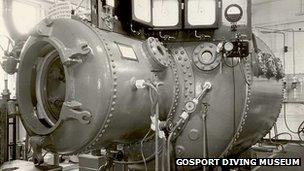Historical diving chambers moved to Gosport museum
- Published
Two simulators which helped develop the science of deep sea diving have been moved to a Hampshire museum.
The seven and 14 tonne diving chambers were previously used by the Royal Navy during and after World War II.
One was used to train so-called "charioteers", navy divers who acted as human torpedoes attaching underwater bombs to enemy ships.
Dr John Bevan of Gosport Diving Museum said: "It's the history behind this kit which makes it so significant."
The chambers - named "100m" and "690m" - were used by the Royal Naval Physiological Laboratory at nearby Alverstoke to recreate the pressures experienced by the human body deep underwater.
During World War II they were used to research the impact of oxygen poisoning which was experienced by the "charioteer" divers when they spent long periods of time underwater steering bombs to their target.
'Human guinea pig'
Dr Bevan, who was involved in later work simulating deep sea dives, described the experience as being like a "human guinea pig" when the divers' endurance was tested to the limits.

The chambers recreated conditions deep underwater
The volunteer-run Gosport Diving Museum opened earlier this year to display the collection of diving equipment held by the Historical Diving Society.
The diving chambers will be displayed in front of the museum which is housed in an old artillery battery.
Dr Bevan said: "They are unique and will raise the profile of the museum. It gives us another dimension to have this kind of heavy equipment."